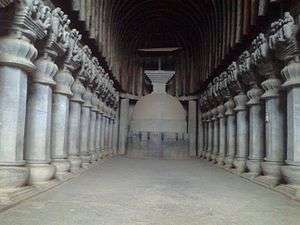Nahapana
| Nahapana | |
|---|---|
| Western Satrap | |
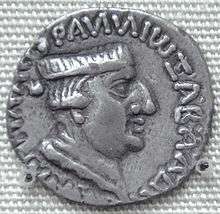 Silver coin of Nahapana, with ruler profile and pseudo-Greek legend "ΡΑΝΝΙΩ ΞΑΗΑΡΑΤΑϹ ΝΑΗΑΠΑΝΑϹ", transliteration of the Prakrit "Raño Kshaharatasa Nahapanasa" (or "King Kshaharata Nahapana"). British Museum. | |
| Reign | 1st or 2nd century CE |
| Predecessor | Bhumaka |
Nahapana (r. 1st or 2nd century CE) was an important ruler of the Western Kshatrapas, descendant of the Indo-Scythians, in northwestern India. According to one of his coins, he was the son of Bhumaka.
Period
The exact period of Nahapana is not certain. A group of his inscriptions are dated to the years 41-46 of an unspecified era. Assuming that this era is the Shaka era (which starts in 78 CE), some scholars have assigned his reign to 119-124 CE.[1] Others believe that the years 41-46 are his regnal years, and assign his rule to a different period. For example, Krishna Chandra Sagar assigns his reign to 24-70 CE,[2] while R.C.C. Fynes dates it to c. 66-71 CE.[3]
Reign
.jpg)
The Periplus of the Erythraean Sea mentions one Nambanus as the ruler of the area around Barigaza. This person has been identified as Nahapana by modern scholars. The text describes Nambanus as follows:[4]
| “ | Beyond the gulf of Baraca is that of Barygaza and the coast of the country of Ariaca, which is the beginning of the Kingdom of Nambanus and of all India. That part of it lying inland and adjoining Scythia is called Abiria, but the coast is called Syrastrene. It is a fertile country, yielding wheat and rice and sesame oil and clarified butter, cotton and the Indian cloths made therefrom, of the coarser sorts. Very many cattle are pastured there, and the men are of great stature and black in color. The metropolis of this country is Minnagara, from which much cotton cloth is brought down to Barygaza. | ” |
| — Periplus 41[5] | ||
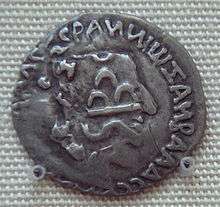
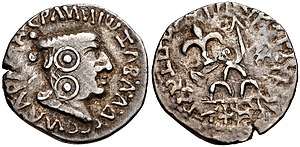
He also established the Kshatrapa coinage, in a style derived from Indo-Greek coinage. The obverse of the coins consists of the profile of the ruler, within a legend in Greek. The reverse represents a thunderbolt and an arrow, within Brahmi and Kharoshthi legends.
Nahapana is mentioned as a donator in inscriptions of numerous Buddhist caves in northern India. The Nasik and Karle inscriptions refer to Nahapana's dynastic name (Kshaharata, for "Kshatrapa") but not to his ethnicity (Saka-Pahlava), which is known from other sources.[6]
Nahapana had a son-in-law named Ushavadata (Sanskrit: Rishabhadatta), whose inscriptions were incised in the Pandavleni Caves near Nasik. Ushavadata was son of Dinika and had married Dakshamitra, daughter of Nahapana. According to the inscriptions, Ushavadata accomplished various charities and conquests on behalf of his father-in-law. He constructed rest-houses, gardens and tanks at Bharukachchha (Bharuch), Dashapura (Mandasor in Malva), Govardhana (near Nasik) and Shorparaga (Sopara in the Thana district). He also campaigned in the north under the orders of Nahapana to rescue the Uttamabhadras who had been attacked by the Malayas (Malavas). He excavated a cave (one of the Pandavleni Caves) in the Trirashmi hill near Nasik and offered it to the Buddhist monks.[7]
Gautamiputra Satakarni
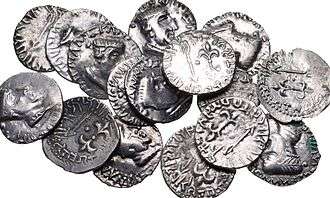

Overstrikes of Nahapana's coins by the powerful Satavahana king Gautamiputra Satakarni have been found in a hoard at Jogalthambi, Nashik District.[8] This suggests that Gautamiputra defeated Nahapana.[3]
Earlier scholars such as James Burgess have pointed out that Gautamiputra Satakarni and Nahapana were not necessarily contemporaries, since Satakarni mentions that the areas conquered by him were ruled by Ushavadata, rather than Nahapana. According to Burgess, there might have been an interval of as much as a century between the reigns of these two kings.[9][10] However, most historians now agree that Gautamiputra and Nahapana were contemporaries, and that Gautamiputra defeated Nahapana.[11] M. K. Dhavalikar dates this event to c. 124 CE, which according to him, was the 18th regnal year of Gautamiputra.[11] R.C.C. Fynes dates event to sometime after 71 CE.[3]
Nahapana was founder of one of the two major Saka Satrap dynasties in north-western India, the Kshaharatas ("Satraps"); the other dynasty included the one founded by Chashtana.[12]
Construction of Buddhist caves

The Western Satraps are known for the construction and dedication of numerous Buddhist caves in Central India, particularly in the areas of Maharashtra and Gujarat.[13][14]
In particular, the chaitya cave complex of the Karla Caves, the largest in South Asia, was constructed and dedicated in 120 CE by Nahapana, according to several inscriptions in the cave.[13][15][16]
An important inscription relates to Nahapana in the Great Chaitya at Karla Caves (Valukura is thought to be an ancient name for Karla Caves):
Success!! By Usabhadata, the son of Dinaka and the son-in-law of the king, the Khaharata, the Kshatrapa Nahapana, who gave three hundred thousand cows, who made gifts of gold and a tirtha on the river Banasa, who gave to the Devas and Bramhanas sixteen villages, who at the pure tirtha Prabhasa gave eight wives to the Brahmanas, and who also fed annually a hundred thousand Brahmanas- there has been given the village of Karajika for the support of the ascetics living in the caves at Valuraka without any distinction of sect or origin, for all who would keep the varsha.
— Inscription of Nahapana, Karla Caves.[17]
Parts of the Nasik caves also were carved during the time of Nahapana,[14] and the Junnar caves also have inscriptions of Nahapana,[18] as well as the Manmodi caves.
| Cave No.10 "Nahapana Vihara" at the Nasik caves |
|---|
|
|
References
- ↑ Buddhist Reliquaries from Ancient India. British Museum Press. 2000. p. 42. ISBN 978-0-7141-1492-7.
- ↑ Krishna Chandra Sagar (1992). Foreign Influence on Ancient India. Northern Book Centre. p. 133. ISBN 978-81-7211-028-4.
- 1 2 3 R.C.C. Fynes 1995, p. 44.
- ↑ "The mention of 'Nambanus' whom the scholars have identified as Nahapana in the Periplus of the Erythrean Sea would help us to solve the problem of Nahapana's time.", in "History of the Andhras" Archived March 13, 2007, at the Wayback Machine.
- ↑ quoted in "The Periplus of the Erythraean Sea: Travel and Trade in the Indian Ocean by a Merchant of the First Century". Fordham University. Retrieved 11 May 2013.
- ↑
- ↑ Magarastra.gov.in Ancient Period Archived March 3, 2007, at the Wayback Machine.
- ↑ Singh, Upinder (2008). A History of Ancient and Early Medieval India: From the Stone Age to the 12th Century. Pearson Education India. p. 383. ISBN 9788131711200.
- ↑ Burgess, James (1880). The Cave Temples of India. Cambridge University Press. pp. 266–268. ISBN 978-1-108-05552-9.
- ↑ Chattopadhyaya, Sudhakar (1974). Some Early Dynasties of South India. Motilal Banarsidass. p. 77. ISBN 978-81-208-2941-1.
- 1 2 M. K. Dhavalikar 1996, p. 135.
- ↑ Students' Britannica India. 4. Encyclopædia Britannica. 2000. p. 375.
- 1 2 3 World Heritage Monuments and Related Edifices in India, Volume 1 ʻAlī Jāvīd, Tabassum Javeed, Algora Publishing, 2008 p.42
- 1 2 Foreign Influence on Ancient India, Krishna Chandra Sagar, Northern Book Centre, 1992 p.150
- ↑ Southern India: A Guide to Monuments Sites & Museums, by George Michell, Roli Books Private Limited, 1 mai 2013 p.72
- ↑ "This hall is assigned to the brief period of Kshatrapas rule in the western Deccan during the 1st century." in Guide to Monuments of India 1: Buddhist, Jain, Hindu - by George Michell, Philip H. Davies, Viking - 1989 Page 374
- ↑ Epigraphia Indica Vol.7, Hultzsch, E. p.58
- ↑ Buddhist Critical Spirituality: Prajñā and Śūnyatā, by Shōhei Ichimura p.40
- ↑ Epigraphia Indica p.78-79
Bibliography
- M. K. Dhavalikar (1996). "Sātavāhana Chronology: A Re-examination". Annals of the Bhandarkar Oriental Research Institute. Bhandarkar Oriental Research Institute. 77 (1/4): 133–140. JSTOR 41702166.
- R.C.C. Fynes (1995). "The Religious Patronage of the Satavahana Dynasty". South Asian Studies. 11 (1): 43–50.
- R.C. Senior "Indo-Scythian coins and history" Vol IV, ISBN 0-9709268-6-3
External links
- , by Durga Prasad, with numerous references to Nahapana.
- Coins of Nahapana
- More coins of Nahapana
- Coins with biography
Indo-Scythian kings, territories and chronology | |||||||||||||||||||||||||||||||||||||||||||||||||||||||||||||||||||||||||||||||||||||||||||||||||||||||||||||||||||||||||||||||||||||||||||||||||||||||||||||||||||||||||||||||||||||||||||||||||||||||||||||||||||||||||||||||||||||
|---|---|---|---|---|---|---|---|---|---|---|---|---|---|---|---|---|---|---|---|---|---|---|---|---|---|---|---|---|---|---|---|---|---|---|---|---|---|---|---|---|---|---|---|---|---|---|---|---|---|---|---|---|---|---|---|---|---|---|---|---|---|---|---|---|---|---|---|---|---|---|---|---|---|---|---|---|---|---|---|---|---|---|---|---|---|---|---|---|---|---|---|---|---|---|---|---|---|---|---|---|---|---|---|---|---|---|---|---|---|---|---|---|---|---|---|---|---|---|---|---|---|---|---|---|---|---|---|---|---|---|---|---|---|---|---|---|---|---|---|---|---|---|---|---|---|---|---|---|---|---|---|---|---|---|---|---|---|---|---|---|---|---|---|---|---|---|---|---|---|---|---|---|---|---|---|---|---|---|---|---|---|---|---|---|---|---|---|---|---|---|---|---|---|---|---|---|---|---|---|---|---|---|---|---|---|---|---|---|---|---|---|---|---|---|---|---|---|---|---|---|---|---|---|---|---|---|---|---|---|
| |||||||||||||||||||||||||||||||||||||||||||||||||||||||||||||||||||||||||||||||||||||||||||||||||||||||||||||||||||||||||||||||||||||||||||||||||||||||||||||||||||||||||||||||||||||||||||||||||||||||||||||||||||||||||||||||||||||
| |||||||||||||||||||||||||||||||||||||||||||||||||||||||||||||||||||||||||||||||||||||||||||||||||||||||||||||||||||||||||||||||||||||||||||||||||||||||||||||||||||||||||||||||||||||||||||||||||||||||||||||||||||||||||||||||||||||
.jpg)
.jpg)
.jpg)
.jpg)
